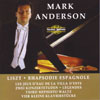Liszt Piano Works
View record and artist detailsRecord and Artist Details
Composer or Director: Franz Liszt
Label: Nimbus
Magazine Review Date: 10/1996
Media Format: CD or Download
Media Runtime: 75
Mastering:
DDD
Catalogue Number: NI5484

Tracks:
| Composition | Artist Credit |
|---|---|
| Rapsodie espagnole |
Franz Liszt, Composer
Franz Liszt, Composer Mark Anderson, Piano |
| (2) Concert Studies |
Franz Liszt, Composer
Franz Liszt, Composer Mark Anderson, Piano |
| Années de pèlerinage année 3, Movement: Les jeux d'eau à la Villa d'Este |
Franz Liszt, Composer
Franz Liszt, Composer Mark Anderson, Piano |
| (2) Légendes |
Franz Liszt, Composer
Franz Liszt, Composer Mark Anderson, Piano |
| Mephisto Waltz No. 3 |
Franz Liszt, Composer
Franz Liszt, Composer Mark Anderson, Piano |
| (5) Kleine Klavierstücke, Movement: E |
Franz Liszt, Composer
Franz Liszt, Composer Mark Anderson, Piano |
| (5) Kleine Klavierstücke, Movement: A flat |
Franz Liszt, Composer
Franz Liszt, Composer Mark Anderson, Piano |
| (5) Kleine Klavierstücke, Movement: F sharp |
Franz Liszt, Composer
Franz Liszt, Composer Mark Anderson, Piano |
| Années de pèlerinage année 2: Italie, Movement: Sonetto 104 del Petrarca |
Franz Liszt, Composer
Franz Liszt, Composer Mark Anderson, Piano |
Author: Bryce Morrison
As his two previous Nimbus discs (3/95 and 7/95 – the latter including a fine performance of Liszt’s Dante Sonata) show, Mark Anderson is a most musicianly pianist. His communicative ardour understandably made him an audience favourite at the 1993 Leeds Piano Competition and here, in this richly diverse programme, he again proves himself a born orator, declaiming Liszt’s fantasy and nobility in generous-hearted fashion. At the same time all these performances (with the exception of the curiously elliptical and prophetic Vier kleine Klavierstucke which are played with a rapt concentration and intensity) have an off-the-cuff flavour with the spirit often engulfing the letter of the score. On this showing Anderson is hardly a natural virtuoso and in a product of Liszt’s glanz period such as the Rhapsodie espagnole he struggles to control the composer’s whirlwind rhetoric (notably at 10'30'', where you almost see the beads of perspiration forming on his brow). There are many other passages pitted with similar failings and so it says much for Anderson’s artistry that he can, ultimately, leave such an abiding sense of warmth and sincerity.
The gnomes may have “danced their ringlets to the whistling ring” to greater effect in the second of the Two Concert Studies, but “Waldesrauchen” is beautifully sensitive and vivacious, with a nice sense of Sacheverall Sitwell’s description of “a wood where the boughs drop down, not so much as leaves but as tassels, which the wind dashes to and fro”. The “Sonetto 104 del Petrarca” ignites on the instant, a vain search for inner peace, but I wish that a similar unease had not invaded the First Legende (those nervy accelerandos in the opening bars, or birdsong more blunt than ecstatic) where there is too little sense of equanimity or glowing religious symbolism. There is too little imperial glitter and impetus in the Third Mephisto Waltz, always among Liszt’s most savagely sardonic utterances, but in the Second Legende Anderson breaks free and, throwing caution to the winds, graphically conveys those moments where poor Saint Francis nearly goes under before his safe arrival and final exultant hymn of praise.
This, then, is a most unusual recital and whether you view Nimbus’s policy of minimal editing as a blessing or a curse you will have to admit that Mark Anderson’s playing is always involving. '
The gnomes may have “danced their ringlets to the whistling ring” to greater effect in the second of the Two Concert Studies, but “Waldesrauchen” is beautifully sensitive and vivacious, with a nice sense of Sacheverall Sitwell’s description of “a wood where the boughs drop down, not so much as leaves but as tassels, which the wind dashes to and fro”. The “Sonetto 104 del Petrarca” ignites on the instant, a vain search for inner peace, but I wish that a similar unease had not invaded the First Legende (those nervy accelerandos in the opening bars, or birdsong more blunt than ecstatic) where there is too little sense of equanimity or glowing religious symbolism. There is too little imperial glitter and impetus in the Third Mephisto Waltz, always among Liszt’s most savagely sardonic utterances, but in the Second Legende Anderson breaks free and, throwing caution to the winds, graphically conveys those moments where poor Saint Francis nearly goes under before his safe arrival and final exultant hymn of praise.
This, then, is a most unusual recital and whether you view Nimbus’s policy of minimal editing as a blessing or a curse you will have to admit that Mark Anderson’s playing is always involving. '
Discover the world's largest classical music catalogue with Presto Music.

Gramophone Digital Club
- Digital Edition
- Digital Archive
- Reviews Database
- Full website access
From £8.75 / month
Subscribe
Gramophone Full Club
- Print Edition
- Digital Edition
- Digital Archive
- Reviews Database
- Full website access
From £11.00 / month
Subscribe
If you are a library, university or other organisation that would be interested in an institutional subscription to Gramophone please click here for further information.




